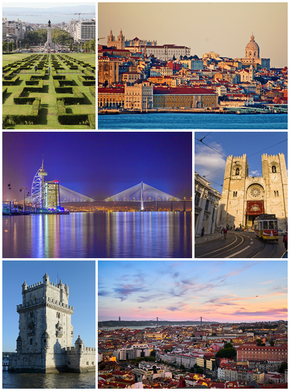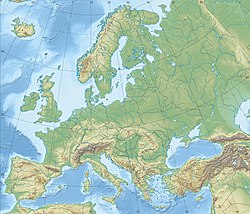Lisbon
Lisbon
Lisboa | |
|---|---|
 Clockwise from top left: Avenida da Liberdade and Eduardo VII Park, view of Praça do Comércio with Alfama in the background, Lisbon Cathedral, view from São Jorge Castle, Belém Tower and Parque das Nações with Vasco da Gama Bridge | |
|
| |
| Etymology: Lisboa, Portuguese derivative of Latin Ulyssippo after Ulysses; and/or Roman Olissipona, for the name of the Tagus | |
| Nickname: Cidade das Sete Colinas (The City of Seven Hills) - Rainha do Mar (Queen of the Sea) - A Cidade da Luz (The City of the Light) | |
| Motto(s): Muito Nobre e Sempre Leal (Very Noble and Always Loyal) | |
| Anthem: Marcha a Lisboa | |
| Coordinates: 38°43′31″N 9°09′00″W / 38.7252668°N 9.1500193°W | |
| Country | Portugal |
| Metro | Lisbon metropolitan area |
| District | Lisbon |
| Historic province | Estremadura |
| Settlement | c. 1200 BCE |
| Roman Olissipo | c. 138 BCE |
| Moorish rule | 711 CE |
| Siege of Lisbon | 1147 CE |
| Civil parishes | (see text) |
| Government | |
| • Type | LAU |
| • Body | Concelho/Câmara Municipal |
| • Mayor | Carlos Moedas |
| • Municipal chair | Helena Roseta |
| Area | |
| • Capital city | 100.05 km2 (38.63 sq mi) |
| Elevation | 2 m (7 ft) |
| Population (2017) | |
| • Capital city | 505,526[1] |
| • Urban | 2,700,000 |
| • Metro | 2,827,514[1] |
| Demonym(s) | Lisboeta Olissiponense Alfacinha (colloquial) |
| Time zone | UTC (WET) |
| • Summer (DST) | UTC+1 (WEST) |
| Postal zone | 1149-014 Lisboa |
| Area code | (+351) 21 XXX-XXXX |
| Patron saint | Vincent of Saragossa and Anthony of Lisbon |
| Municipal address | Praça do Município, 1 1149-014 Lisboa |
| Municipal holidays | 13 June (St. Anthony's Day) |
| Website | www.cm-lisboa.pt |
Lisbon (Portuguese: Lisboa) is the capital city of Portugal. It is the largest city of Portugal. The city has a population of about half million people. In Lisbon's urban area live around 2.8 million people, being the 10th-most populous urban area in the European Union.[2] Lisbon is placed on the right bank (western) of the Tagus River, near the outfall. It has a pleasant climate and has about 220 days of sunshine each year. There are many beautiful beaches close to the city. There are also many seafood restaurants, historical sites and monuments, being one of the oldest cities in the world.[3]
Geography
[change | change source]Civil parishes
[change | change source]The municipality of Lisbon have 24 freguesias (civil parishes).[4]
Transportation
[change | change source]Metro
[change | change source]The Lisbon Metro connects the city centre to different districts, it also reaches some suburbs around the Lisbon metropolitan area, like Amadora and Loures.
Trams
[change | change source]Trams are a traditional public transport in Lisbon. It was first introduced in 1901, many of the electric trams were originally imported from the US,[5] and were called americanos. Trams in Lisbon are coloured yellow and is one of the tourist icons of the city, and their size is great for steep hills and narrow streets of the central city.[6][7]
References
[change | change source]- ↑ 1.0 1.1 "PORDATA - População residente: Total e por grandes grupos etários". Archived from the original on 2019-06-30. Retrieved 2019-09-20.
- ↑ Demographia: World Urban Areas - demographia.com, 06.2021
- ↑ H. V. Livermore (1973). Portugal: A Short History. Edinburgh University Press. p. 4. ISBN 978-0-85224-207-0.
- ↑ Diário da República. "Law nr. 56/2012, pages 6454–6460" (pdf) (in Portuguese). Archived from the original on 29 November 2014. Retrieved 20 November 2014.
- ↑ Electrical World. McGraw-Hill. 1900. p. 566.
- ↑ [1] Archived 3 January 2007 at the Wayback Machine Information from Carris, Lisbon transportation company.
- ↑ "Luso Pages - Lisbon (Portugal) Trams". Archived from the original on 15 May 2011. Retrieved 10 March 2011. Details of Lisbon's trams, from Luso Pages
Other websites
[change | change source]- Official page of the city (in Portuguese)
- Lisbon Photos a collection of Photos, showing Lisbon as it is to visitors.



